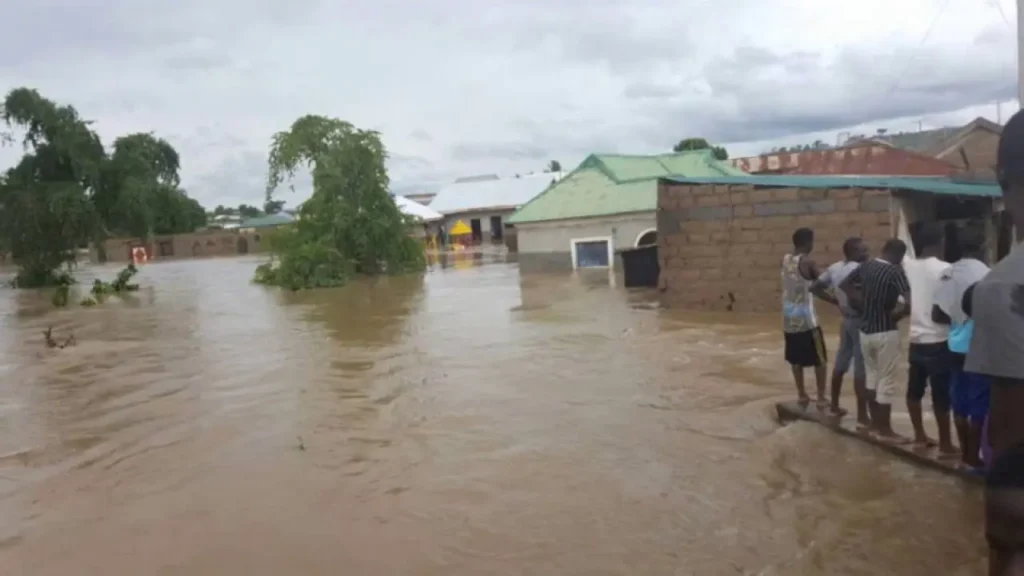Akwa Ibom, Bayelsa, Cross River and 32 other states are prone to high risk of flooding, the Federal Government’s 2023 Annual Flood Outlook, AFO, Friday, indicated.
The Minister of Water Resources, Suleiman Adamu stated this during the 2023 Annual Flood Outlook put together by the Nigeria Hydrological Services Agency and presented to the public in Abuja on Friday, February 17.
Adamu said the 2023 AFO on the theme Flood Prediction and Impact on Socio-Economic Livelihood which aligns with Sustainable Development Goal 6 borders on reducing exposure and vulnerability to climate-related extreme events and other economic, social, and environmental shocks and disasters.
Also read: Flooding Displaces One Million people in Nigeria- Ministry
He acknowledged that Nigeria, like other countries, has had its fair share of devastating effects of flood, pointing out that the country experienced the worst flood disaster in 2022 which the 36 States and the Federal Capital Territory, FCT, were impacted by the flood, whereby both private and public infrastructure, farmlands, livestock and human lives were terribly and horribly affected, with over 1.4 million people affected and 662 persons killed and thousands of people displaced.
According to the Minister, the World Bank’s estimate on damages caused by the 2022 flood was put at $6.68 billion.
Based on the horror of the 2022 flood, he said President Muhammadu Buhari inaugurated the Presidential Committee for the Development of Action Plan for Preventing Flood Disaster in Nigeria on November 3, 2022.
“This 2023 Annual Flood Outlook, AFO, is therefore coming at the right time as it will serve as a valuable resource to enrich the work of the Presidential Committee.
“It is also aimed at detailing information on the probable flood risk areas in 2023 with their degree of vulnerability.
“The forecasts for 2023 show that 178 local government areas in 32 states of the Federation and the FCT fall within the high flood risk areas.
“While 224 LGAs in 35 States including FCT, fall within the moderate flood risk areas. The remaining 372 LGAs fall within the low flood risk areas.
“The high flood risk states are as follows; Adamawa, Abia, Akwa Ibom, Anambra, Bauchi, Bayelsa, Benue, Cross-River, Delta, Ebinyi, Ekiti, Edo, Gombe, Imo, Jigawa, Kaduna, Kano, Kebbi, Kogi, Kwara, Lagos, Nasarawa, Niger, Ogun, Ondo, Osun, Oyo, Rivers, Sokoto, Taraba, Yobe, Zamfara, and the Federal Capital Territory.
“High flood risk areas between the months of April and November 2023, and the level of floods in this category are expected to be high in terms of impact on the population, agriculture, livelihood livestock and infrastructure,’’ the Minister stated.
He also explained that, “Part of 66 LGAs across the country falls within the highest floods areas in the month of April, May and June, while parts of 114 LGAs falls in the month of July, August and September are part of 100 LGAs falls in the month of October and November 2023.
Meanwhile, the 2023 AFO also indicated moderate risk areas of the country during the flood period, according to the Minister.
“Moderate flood risk areas; Moderate impact of flood are expected in parts of 41 LGAs within the month of April, May and June, and in parts of 199 LGAs within the months of July, August and September, and parts of 73 LGAs within the months of October and November 2023,” he said.
The Minister also made it known that Bayelsa Cross-River, Delta, Edo Lagos, Ogun, River and Dodondo, will be experiencing coastal flooding due to rising sea level and tidal surge which will impact on fishing, wildlife habitation, and river navigation.
“For urban flooding, flash and urban flood will be experience in urban city centers across the country, among the cities are Lagos, Kaduna, Suleja, Gombe, Yola, Markodi Abuja, Lafia, Asaba, Port Harcourt, Yenaguwa, Ibadan, Abeokuta, Benin City, Benin- Kebbi, Sokoto, Lokoja, Maduguri, Kano Oshogbo, Ado-Ekiti, Abakaliki, Awka, Nsukka, Calabar and Owerri.”
However, he (Adamu) called on State and Local Governments to brace up ahead of the predictions by being proactive and pragmatic to ensure the necessary environmental and economic preparations are strategically and adequately made to protect lives and property on the heels of the devastating flood that terribly submerged the country, hence such emergency should be avoided and prevented.
He also commended the Nigeria Hydrological Services Agency, NIHSA, for the improved forecasts on flood as presented in the AFO.

